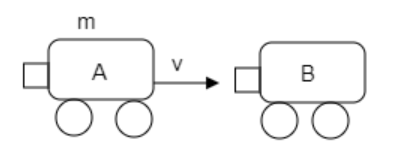Question
Question: A \(242 \times {10^4}{\text{kg}}\) freight car moving along a horizontal railroad spur track at \(7....
A 242×104kg freight car moving along a horizontal railroad spur track at 7.2kmh−1 strikes a bumper and its coil springs experience a maximum compression of 30cm in stopping the car. Find the elastic potential energy of the springs at the instant when they are compressed by 15cm .
A) 12.1×104J
B) 121×104J
C) 1.21×104J
D) 1.21×106J
Solution
When the car strikes the bumper in front of it, the coil springs in the bumper compresses. Since energy can neither be created nor destroyed, a transfer of kinetic energy of the moving car to potential energy of the spring takes place. When the springs suffer maximum compression, the entire kinetic energy will be converted into the potential energy of the springs.
Formulas used:
-The kinetic energy of a moving body is given by, K=21mv2 where m is the mass of the body and v is its velocity.
-The elastic potential energy of a spring is given by, U=21kx2 where k is the spring constant and x is the amount of compression of the spring.
Complete step by step answer.
Step 1: Sketch a rough diagram of the situation under consideration and list the known parameters.

In the above figure, we see that the freight car A moves with some velocity v and strikes the bumper of the car B in front of it. A transfer of energy takes place.
The mass of the freight car is m=242×104kg and its moves with velocity v=7.2kmh−1=2ms−1 .
The maximum compression suffered by the coil springs is xmax=30cm=0.3m.
The elastic potential energy of the springs for compression x=15cm=0.15m.
Step 2: Express the relation for the kinetic energy of the freight car to find its value by substitution.
The kinetic energy of a moving freight car is given by, K=21mv2 -------- (1)
Substituting values for m=242×104kg and v=2ms−1 in equation (1) we get, K=21×242×104×22=484×104J
Thus the kinetic energy of the freight car is K=484×104J .
Step 3: Express the final potential energy of the spring using the principle of energy transfer.
As the car strikes the car in front of it, its entire kinetic energy gets transferred to potential energy and is stored in the spring as it comes to a halt.
So, we can express K=Ufinal ---------- (2)
The final elastic potential energy of a spring given by, Ufinal=21kxmax2
where k is the spring constant and xmax is the maximum compression of the spring.
Based on equation (2) we can express the final elastic potential energy as K=21kxmax2 ------ (3)
Substituting the values for xmax=0.3m and K=484×104J in equation (3) we get, 484×104=21k×0.32
Then the spring constant will be k=0.322×484×104
Step 4: Using the obtained value of the spring constant, find the elastic potential energy when the compression of the springs is x=0.15m.
The elastic potential energy of the springs is given by, U=21kx2 --------- (4)
where k is the spring constant and x is the compression of the springs.
Substituting values for k=0.322×484×104 and x=0.15min equation (4) we get, U=21×0.322×484×104×0.152=1.21×106J
Thus the required elastic potential energy of the springs is U=1.21×106J or U=121×104J
So the correct options are B and D.
Note: The kinetic energy of the car equals the potential energy of the springs only when compression is maximum. Then the car must have come to a stop. While substituting values of physical quantities in any equations their values must be expressed in their respective S.I. units. If not, the necessary conversion of units must be done. Here, the velocity of the freight car v=7.2kmh−1 is converted to its S.I. unit as v=7.2×185=2ms−1 while substituting in equation (1).
